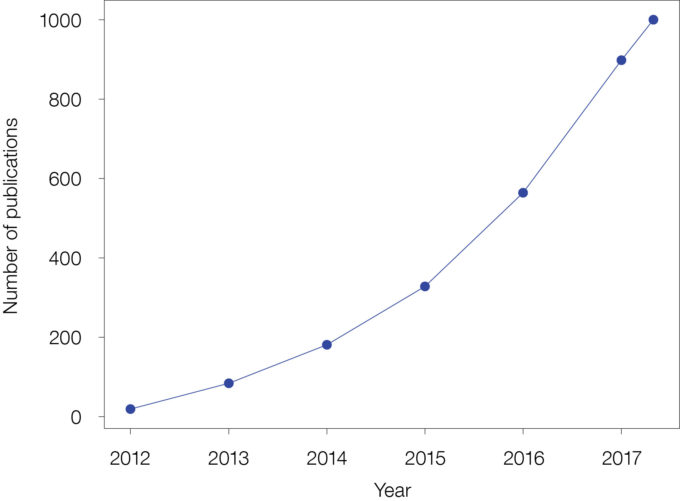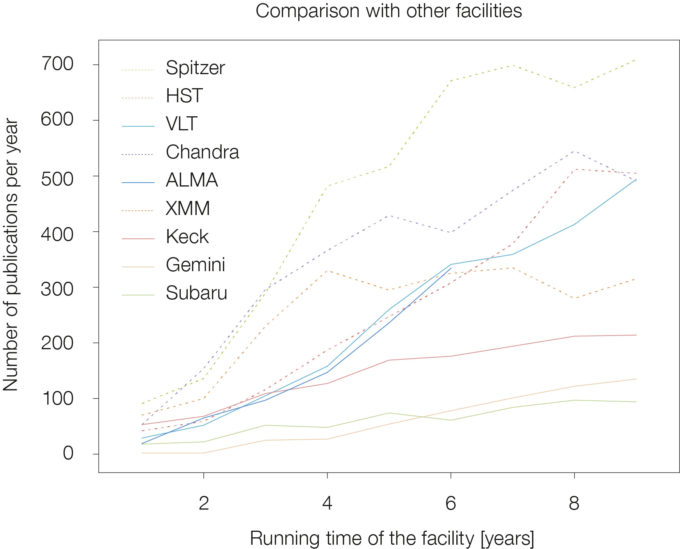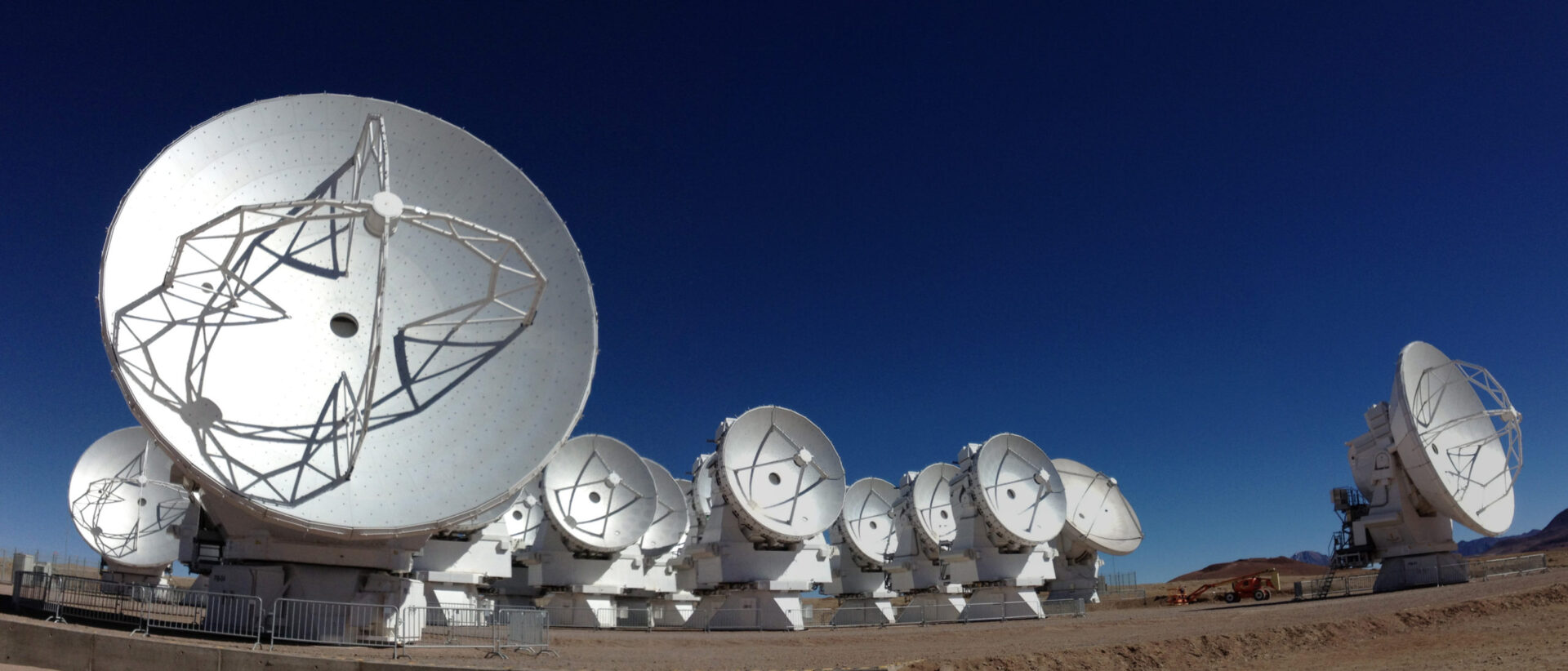ALMA Reaches 1000 Published Papers
The Atacama Large Millimeter/submillimeter Array (ALMA) has reached an important milestone with the publication of the 1000th peer-reviewed paper using ALMA data. The paper was Spatial variations in Titan's atmospheric temperature: ALMA and Cassini comparisons from 2012 to 2015 by Alexander E. Thelen et al. — which presents a detailed investigation of the atmospheric temperature of Saturn's largest moon, Titan.

ALMA, the Atacama Large Millimeter/submillimeter Array, reached an important milestone in April 2018 with the publication of the 1000th peer-reviewed paper using ALMA data. The paper was Spatial variations in Titan's atmospheric temperature: ALMA and Cassini comparisons from 2012 to 2015 by Alexander E. Thelen et al. — which presents a detailed investigation of the atmospheric temperature of Saturn's largest moon, Titan. This plot shows the growth of ALMA papers through the years since science operations began. Credit: ALMA (ESO/NAOJ/NRAO)
The data behind the work of Thelen et al. was originally taken to help calibrate the telescope and have been available since 2013. ALMA data is archived online, meaning many discoveries by different researchers can be made from a single observational programme, or from data taken for an entirely different purpose, as is the case here. The full range of papers presenting observations and discoveries using ALMA data is also available online from the ESO telbib database [1].
The ALMA bibliography is jointly maintained by the librarians at ESO and NRAO, together with NAOJ. This joint approach underlines the general spirit of collaboration that also characterizes the ALMA project at large [2].
The first ALMA data paper appeared in 2012, and since then ALMA, the largest ground-based astronomical project in existence, has been instrumental in a wide range of discoveries including detecting the ingredients of young exoplanetary systems, capturing galaxy assembly in the early Universe and detecting the formation of the first stars. ALMA can make these discoveries by studying light with wavelengths of around one millimeter. Such light originates from some of the coldest objects in the Universe, such as the earliest and most distant galaxies in the Universe, as well as molecular clouds — dense regions of gas and dust where new stars are born.
ALMA is a single telescope composed of 66 high-precision antennas, operating at wavelengths of 0.32 to 3.6 millimeters. Its main 12-meter array has 50 antennas, 12 meters in diameter each, acting together as an interferometer. This already powerful collection of antennas is complemented by an additional compact array of four 12-meter and twelve 7-meter antennas.
Since the first data was produced by ALMA, the rate of published papers has grown rapidly, and data from this astronomically-productive powerhouse now leads to an average of one refereed scientific article per day. With 1000 papers published so far, this powerful instrument has already broadened our understanding of the most distant reaches of our Universe and will continue to help answer our cosmic queries in the future.

ALMA, the Atacama Large Millimeter/submillimeter Array, reached an important milestone in April 2018 with the publication of the 1000th peer-reviewed paper using ALMA data. The paper was Spatial variations in Titan's atmospheric temperature: ALMA and Cassini comparisons from 2012 to 2015 by Alexander E. Thelen et al. — which presents a detailed investigation of the atmospheric temperature of Saturn's largest moon, Titan. This plot compares the growth of ALMA papers through the years since science operations began with other facilities, both on the ground and in space. Credit: ALMA, the Atacama Large Millimeter/submillimeter Array, reached an important milestone in April 2018 with the publication of the 1000th peer-reviewed paper using ALMA data. The paper was Spatial variations in Titan's atmospheric temperature: ALMA and Cassini comparisons from 2012 to 2015 by Alexander E. Thelen et al. — which presents a detailed investigation of the atmospheric temperature of Saturn's largest moon, Titan. This plot shows the growth of ALMA papers through the years since science operations began. Credit: ALMA (ESO/NAOJ/NRAO)
Notes
[1] ALMA has defined a clear citation policy for the use of data in publications so that observations can be clearly associated with publications. Information about the ALMA bibliography methodology, along with lessons learned from the first years of operation, can be found here and here.
[2] The ALMA bibliography curators are Uta Grothkopf, Silvia Meakins and Dominic Bordelon, ESO Library, [email protected]; Marsha Bishop, NRAO Library, [email protected] and Tomoko Nishikawa, NAOJ ALMA office, [email protected].
Additional Information
ALMA, an international astronomy facility, is a partnership of ESO, the U.S. National Science Foundation (NSF) and the National Institutes of Natural Sciences (NINS) of Japan in cooperation with the Republic of Chile.
Links
- ALMA’s 1000th published paper
- ALMA data citation policy
- ESO’s telbib publication database system
- A collection of ESO press releases featuring ALMA
- A collection of images taken with ALMA
Contacts
-
Nicolás Lira
Education and Public Outreach CoordinatorJoint ALMA Observatory, Santiago - ChilePhone: +56 2 2467 6519Cel: +56 9 9445 7726Email: [email protected] -
Richard Hook
Public Information Officer, ESOGarching bei München, GermanyPhone: +49 89 3200 6655Cel: +49 151 1537 3591Email: [email protected] -
Masaaki Hiramatsu
Education and Public Outreach Officer, NAOJ Chile -
Charles E. Blue
Public Information OfficerNational Radio Astronomy Observatory Charlottesville, Virginia - USAPhone: +1 434 296 0314Cel: +1 202 236 6324Email: [email protected]
